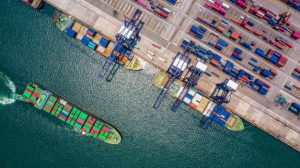Sea freight is the most commonly used formula and contract when it comes to sea freight transport. These contracts specify the sea freight system and are subject to numerous variables, such as cargo type, cargo volume or method, which will define the final price of each shipment.
It is therefore not that easy to calculate the sea freight price as it does not depend solely on the carrier rate, far from it. We are now going to talk about the factors may determine sea freight.
Dispatch and handling costs
An important variable in sea freight is the cost associated with the handling and dispatch of the goods at the loading and unloading ports. Depending on the transport requirements, some expenses can be deducted, while other cannot be.
Port-to-port carriage, for example, will involve a flat fee whenever this involves a full container. The rate base would be the sea freight itself.
However, door-to-door transport will include all the expenses mentioned above as well as land transport fees to and from the port, either at the time of picking up as well as delivering the goods.
Loading method in a container
One of the major differences in freight is the way that the container is loaded, something that is going to depend on the volume of the goods to be transported.
FCL sea freight
The acronym FCL (Full Container Load) refers to the use of an entire container for a single cargo load. It has several benefits, the most important of which is its better value for money for goods equal to or greater than 15m3. The shipping company charges a flat rate for each type of container, greatly simplifying the freight.
It also provides additional security for the load due to being sealed and all belonging to the same owner. Finally, this results in a speedier delivery, since the container is transported directly from its source to destination without stopping at any intermediate ports.
LCL sea freight
The alternative, LCL shipping (Less Container Load) is much more suitable and viable for small cargo volumes. This method involves cargo groupage, which consists of grouping moderate good volumes from various shippers in order to fill a container.
LCL shipping can be a less swift alternative, but one that is still good value, due to the fact that the cost is shared. In this case, freight is calculated on the basis of tonnes loaded.
Sea freight surcharges
Apart from pure sea freight, don’t forget that there may be other surcharge items that are essential when obtaining a final price.
BAF (Bunker Adjustment Factor)
This is the surcharge applied to correct unforeseen fuel price fluctuations.
CAF (Currency Adjustment Factor)
This is a surcharge applied to cover any possible currency rate variations. It is applied as a percentage on the freight, and is generally set in relation to the American dollar.
IMO (Dangerous goods)
This is the penalty for the transport of dangerous goods that should be added to the basic freight calculated on the basis of the number of containers or tonnes of merchandise.
Surcharges for transport
There are other possible surcharges for goods transported through specific areas. This is the case of the SCT (Suez Canal Transit) that is applicable to goods that pass through the Suez Canal; the PCS (Panama Canal Surcharge) for goods passing through the Panama Canal; and the Aden surcharge (Aden Gulf Surcharge), which is intended to cover expenses related to piracy attacks in the Gulf of Aden.
Apart from the above, we must also not forget banking, administrative and customs costs.
So, we can see that there are a wide range of surcharges, depending on the particulars of each logistics operation. There are also different sea freight methods, each of which involves different conditions and obligations for the charterer and charteree. Hence the importance of a reliable freight forwarder that searches for the best shipping option for your goods.


